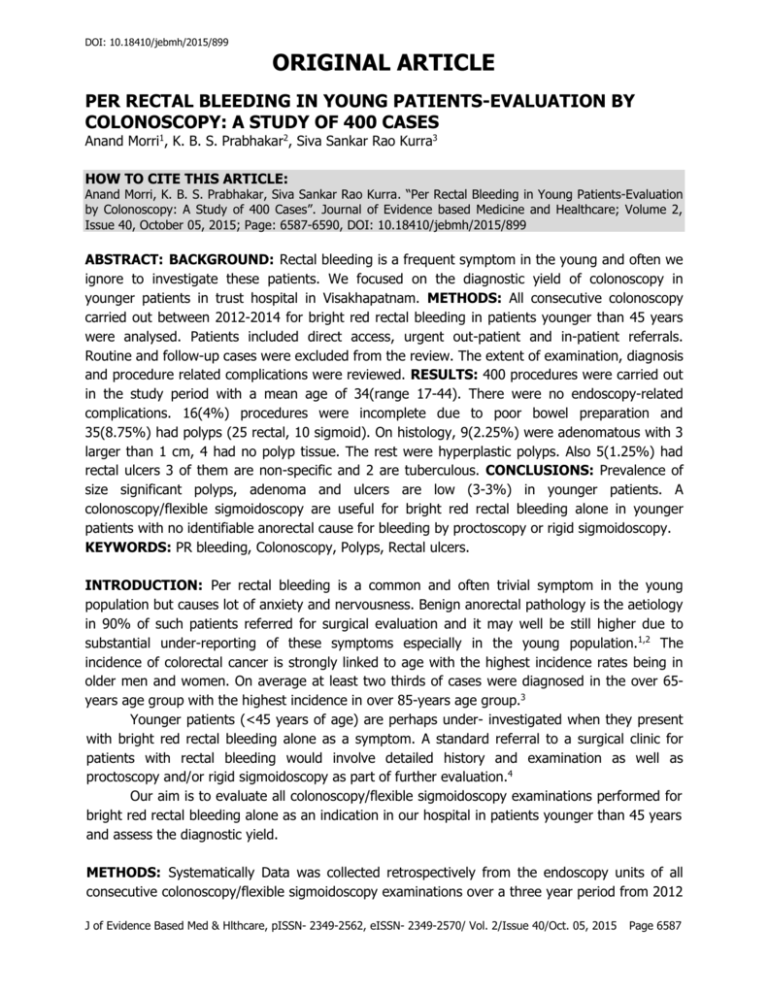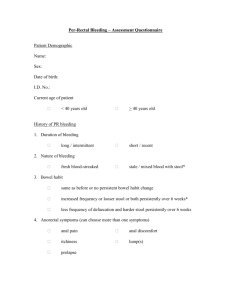per rectal bleeding in young patients
advertisement

DOI: 10.18410/jebmh/2015/899 ORIGINAL ARTICLE PER RECTAL BLEEDING IN YOUNG PATIENTS-EVALUATION BY COLONOSCOPY: A STUDY OF 400 CASES Anand Morri1, K. B. S. Prabhakar2, Siva Sankar Rao Kurra3 HOW TO CITE THIS ARTICLE: Anand Morri, K. B. S. Prabhakar, Siva Sankar Rao Kurra. “Per Rectal Bleeding in Young Patients-Evaluation by Colonoscopy: A Study of 400 Cases”. Journal of Evidence based Medicine and Healthcare; Volume 2, Issue 40, October 05, 2015; Page: 6587-6590, DOI: 10.18410/jebmh/2015/899 ABSTRACT: BACKGROUND: Rectal bleeding is a frequent symptom in the young and often we ignore to investigate these patients. We focused on the diagnostic yield of colonoscopy in younger patients in trust hospital in Visakhapatnam. METHODS: All consecutive colonoscopy carried out between 2012-2014 for bright red rectal bleeding in patients younger than 45 years were analysed. Patients included direct access, urgent out-patient and in-patient referrals. Routine and follow-up cases were excluded from the review. The extent of examination, diagnosis and procedure related complications were reviewed. RESULTS: 400 procedures were carried out in the study period with a mean age of 34(range 17-44). There were no endoscopy-related complications. 16(4%) procedures were incomplete due to poor bowel preparation and 35(8.75%) had polyps (25 rectal, 10 sigmoid). On histology, 9(2.25%) were adenomatous with 3 larger than 1 cm, 4 had no polyp tissue. The rest were hyperplastic polyps. Also 5(1.25%) had rectal ulcers 3 of them are non-specific and 2 are tuberculous. CONCLUSIONS: Prevalence of size significant polyps, adenoma and ulcers are low (3-3%) in younger patients. A colonoscopy/flexible sigmoidoscopy are useful for bright red rectal bleeding alone in younger patients with no identifiable anorectal cause for bleeding by proctoscopy or rigid sigmoidoscopy. KEYWORDS: PR bleeding, Colonoscopy, Polyps, Rectal ulcers. INTRODUCTION: Per rectal bleeding is a common and often trivial symptom in the young population but causes lot of anxiety and nervousness. Benign anorectal pathology is the aetiology in 90% of such patients referred for surgical evaluation and it may well be still higher due to substantial under-reporting of these symptoms especially in the young population.1,2 The incidence of colorectal cancer is strongly linked to age with the highest incidence rates being in older men and women. On average at least two thirds of cases were diagnosed in the over 65years age group with the highest incidence in over 85-years age group.3 Younger patients (<45 years of age) are perhaps under- investigated when they present with bright red rectal bleeding alone as a symptom. A standard referral to a surgical clinic for patients with rectal bleeding would involve detailed history and examination as well as proctoscopy and/or rigid sigmoidoscopy as part of further evaluation.4 Our aim is to evaluate all colonoscopy/flexible sigmoidoscopy examinations performed for bright red rectal bleeding alone as an indication in our hospital in patients younger than 45 years and assess the diagnostic yield. METHODS: Systematically Data was collected retrospectively from the endoscopy units of all consecutive colonoscopy/flexible sigmoidoscopy examinations over a three year period from 2012 J of Evidence Based Med & Hlthcare, pISSN- 2349-2562, eISSN- 2349-2570/ Vol. 2/Issue 40/Oct. 05, 2015 Page 6587 DOI: 10.18410/jebmh/2015/899 ORIGINAL ARTICLE to 2014. A younger patient, for the purpose of the study, is defined as one aged 45 years or less.5 Patients who had rectal bleeding as their only symptom were included in the study. The presence of any associated bowel symptoms, anaemia, raised faecal calprotectin, weight loss, palpable mass, previous history of inflammatory bowel disease or polyps and family history of polyps served as exclusion criteria for the study. Data regarding the extent of endoscopic examination, endoscopic diagnosis and procedure-related complications were recorded. Patients included were with per rectal bleeding, suspected cancer, all urgent and in-patient referrals. Routine and follow up referrals were excluded for the purpose of this study. RESULTS: Over a three year period, 400 patients were identified after the exclusion criteria were applied. All patients underwent flexible sigmoidoscopy for rectal bleeding alone. Patients received PEGLEC for their bowel preparation. Midazolam is given for pain relief and sedation. The age range of patients in the study group ranged from 17 to 44 years with a mean of 34.9 years. The study group comprised of 225 female patients and 175 male patients. Although no procedurerelated complications were reported in the study group, 16 flexible sigmoidoscopies were incomplete due to pain and/or poor bowel preparation. The various endoscopic diagnoses offered on flexible sigmoidoscopy are haemorrhoids, diverticular disease, anal fissure, solitary rectal ulcer, polyps and the proctitis. Of the 400 patients who had no mucosal pathology identified at colonoscopy/ flexible sigmoidoscopy, over 90% reported their symptoms, have resolved completely at the time of the procedure and in the remaining patients their symptoms were attributed to internal haemorrhoids. At endoscopy, 35 polyps were identified of which 25 were in the rectum and 10 sigmoid. Standard fluid assisted polypectomy was carried out for larger polyps (>5mm) whilst the remaining were hot snared. Histological assessment revealed nine tubulovillous adenomas (two larger than 1 cm), two had no polyp tissue on histology and the rest were hyperplastic polyps of the rectum. 5 patients had rectal ulcers in which 3 are non-specific and 2 are tuberculosis DISCUSSION: Bright red rectal bleeding is a common symptom and often under-reported especially in the younger population due to the varied perception levels of health concerns.6 Rectal bleeding and/or a change in bowel habit (frequent bowel motions or increased looseness) in association with increasing age (over 60 years) serves as a powerful predictor of colorectal cancer in such population.7 Wauters et al reported that the positive predictive value of rectal bleeding as a symptom of colorectal cancer increases with age with figures of 21% in 70-79 years age group whilst it is <1% in patients younger than 50 years.8 The age specific incidence of colorectal cancers increases from around 50 years of age with the highest incidence in the over 85 years age group.3 Prevalence of advanced adenomas, like cancer, increases with age and this has been reported by several studies.9'10 J of Evidence Based Med & Hlthcare, pISSN- 2349-2562, eISSN- 2349-2570/ Vol. 2/Issue 40/Oct. 05, 2015 Page 6588 DOI: 10.18410/jebmh/2015/899 ORIGINAL ARTICLE Mathew J et al. have reported an adenoma incidence of 2% in patients younger than 45 years with rectal bleeding in their study.11 From our study the adenoma rate was 1.7% including an advanced adenoma rate of 0.4% and a cancer rate at 0.4%. However age alone should not serve as the differentiating factor in evaluating these patients. In the younger, lower- risk patient with suspected inflammatory bowel disease, faecal calprotectin is a useful screening tool. Waugh et al reported that a negative faecal calprotectin result is a reliable way of excluding IBD thus reducing the need and cost for invasive investigations like colonoscopy.12 Various epidemiological studies have reported no colorectal cancer diagnosis in patients with rectal bleeding who are younger than 50 years of age and these were based on long term follow up period of up to 10 years.13,14 CONCLUSION: It is reasonable to say a high index of suspicion, especially when symptoms persist along with no identifiable ano-rectal pathology should warrant further evaluation. Selective use of colonoscopy in such situations is very useful to arrive accurate diagnosis and to relieve the anxiety and nervousness of the patients REFERENCES: 1. Tally NJ, Jones M. Self-reported rectal bleeding in a United States community. Prevalence, risk factors, and health care seeking. Am J Gastroenterol. 1998; 93: 2179-83. 2. Penner RM, Majumdar SR. Approach to minimal bright red bleeding per rectum. In: Rose BD eds. A Book. Vol. 93. Waltham: UpTo Date; 2007. 3. Cancer Research UK. Bowel cancer incidence statistics, 2014. Available at: http://www.cancerresearchuk.org/cancerinfo/cancerstats/types/bowel/incidence/ukbowel- cancer-incidence-statistics. Accessed 11 June 2014. 4. Martha A. Ferguson. Office evaluation of rectal bleeding. Clin Colon Rectal Surg. 2005 Nov; 18(4): 249-54. 5. The Royal College of Surgeons of England. Commissioning guide for rectal bleeding, 2013. Available at: http://www.rcseng.ac.uk/surgeons/surgical- standards/docs/rectal-bleedingdraft- commissioning-guidance. 6. Crosland A, Jones R. Rectal bleeding: prevalence and consultation behaviour. Br Med J. 1995; 311: 486-8. 7. Cade D, Selvachandran S, Hodder R, Ballal M. Prediction of colorectal cancer by consultation questionnaire. Lancet. 2002; 360: 2080. 8. Wauters H, Van Casteren V, Buntinx F. Rectal bleeding and colorectal cancer in general practice: diagnostic study. Br Med J. 2000; 321: 998-9. 9. Chung SJ, Kim YS, Yang SY, Song JH, Park MJ, Kim JS, et al. Prevalence and risk of colorectal adenoma in asymptomatic Koreans aged 40-49 years undergoing screening colonoscopy. J Gastroenterol Hepatol. 2010; 25(3): 519-25. 10. Brenner H, Althenhofen L, Hoffmeister M. Sex, age, and birth cohort effects in colorectal neoplasms: a cohort analysis. Ann Intern Med. 2010 Jun; 150(ll): 697-70. J of Evidence Based Med & Hlthcare, pISSN- 2349-2562, eISSN- 2349-2570/ Vol. 2/Issue 40/Oct. 05, 2015 Page 6589 DOI: 10.18410/jebmh/2015/899 ORIGINAL ARTICLE 11. Mathew J, Shankar P, Aldean IM. Audit on flexible sigmoidoscopy for rectal bleeding in a district general hospital: are we over-loading the resources? Postgrad Med J. 2004; 80: 3840. 12. Waugh N, Cummins E, Royle P, Kandala N-B, Shyangdan D, Arasaradnam R, et al. Faecal calprotectin testing for differentiating amongst inflammatory and non-inflammatory bowel diseases: systematic review and economic evaluation. Health Technol Assess. 2013; 17(55): xv- xix, 1-211. 13. Helfand M, Marton K, Zimmer-Gembeck MJ, Sox HC Jr. History of visible rectal bleeding in a primary care population. JAMA. 1997; 277: 44-8. 14. Fitjen G, Starmans R, Muris JW, Schouten HJ, Blijham GH, Knottnerus JA. Predictive value of signs and symptoms of colorectal cancer in patients with rectal bleeding in general practice. Fam Pract. 1995; 12: 279-86. AUTHORS: 1. Anand Morri 2. K. B. S. Prabhakar 3. Siva Sankar Rao Kurra PARTICULARS OF CONTRIBUTORS: 1. Associate Professor, Department of General Surgery, Siddhartha Medical College, Vijayawada. 2. Associate Professor, Department of General Surgery, Siddhartha Medical College, Vijayawada. 3. Professor, Department of General Surgery, Siddhartha Medical College, Vijayawada. NAME ADDRESS EMAIL ID OF THE CORRESPONDING AUTHOR: Dr. Anand Morri, Associate Professor, Department of General Surgery, Siddhartha Medical College, Vijayawada. E-mail: anandmorri@yahoo.com Date Date Date Date of of of of Submission: 18/09/2015. Peer Review: 19/09/2015. Acceptance: 22/09/2015. Publishing: 29/09/2015. J of Evidence Based Med & Hlthcare, pISSN- 2349-2562, eISSN- 2349-2570/ Vol. 2/Issue 40/Oct. 05, 2015 Page 6590









